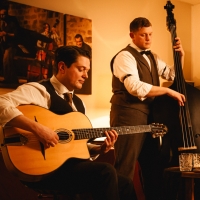DjangoBooks.com
Welcome to our Community!
Categories
- 17.9K All Categories
- 394 General
- 255 Welcome
- 10 Archtop Eddy's Corner
- 74 CD, DVD, and Concert Reviews
- 29 FAQ
- 9 Gypsy Jazz Italia
- 17 Photos
- 24 Gypsy Picking
- 3 Unaccompanied Django
- 1 Pearl Django Play-Along Vol.1
- 1 Gypsy Fire
- 21 Gypsy Rhythm
- 551 Gypsy Jazz University - Get Educated
- 104 Gypsy Jazz 101
- 175 Repertoire
- 128 History
- 88 Technique
- 39 Licks and Patterns
- Daniel Givone Manouche Guitare Method Users Group
- 17 Eddie Lang Club
- 995 Gypsy Jazz Gear
- 644 Guitars, Strings, Picks, Amps, Pickups and Other Accessories
- 315 Classifieds
- 36 Recording
- 38 Other Instruments
- 17 Violin
- 3 Mandolin
- 6 Accordion
- 3 Bass
- 9 Woodwinds
- 196 Gypsy Jazz Events
- 78 North America
- 80 Europe
- 38 International











Comments
Then this is very "unlike" the classic round back mandolin pliage where the sides are shaped to fit the pliage.
In a guitar, the pliage serves several purposes. Not only does it lend the stiffness of the arch, but it is also a method of getting the top back down to the straight sides without having to cold bend the top over the braces. The stiffness of the top with the grain would overcome the arch cut into the braces and the top would flatten out. The pliage overcomes this problem and forms a nice arch which gives considerable additional stiffness to the bridge area without any additional weight. To be effective, the arch needs to be fairly substantial.
When you say "arch" are you referring to an arch longitudinally (butt to neck) or across the guitar top side to side ? Or both as is done by many classical and flamenco guitar makers? ( doming)
If side to side, is the arch induced by the braces and how does this affect the pliage. seems incongruous as a plane ususually bends in only one direction.
Ditto longitudinally.
As the mandolins have no arching.. the pliage serves as an all purpose structure.
Jeff
This heat bent technique we see on the GJ guitars is an attempt to form a dome in the top that isn't forced so that there isn't any internal tension in the system/structure. So in theory that makes for more response. The dome is also more resistant to the pressure of the strings and so the structure tends to maintain its shape over time, which makes for a more stable instrument.
The heat bent technique seems a bit more gentle than the Neapolitan method. Perhaps.
The instruments I've played that have the pliage seem to have a bit more edge, a bit more bite on initial attack.
I have here in my hands an early 1900's American made bowl back, a Wurlitzer, perhaps Washburn. By placing a mirror in the sound hole.. scorch marks, no slice.. though I have owned "sliced" units.
Seiffert, (RIP) the father of the "modern" bowlback did not slice his tops, they were heat bent then glued.
The heat bent pliage still does not explain the "doming" to me. Perhaps I am thick, but to dome, one must bend two directions ( at minimum).
When the edges of the top are brought down to the tops of the sides, I would assume that this creates tension. Can't see how it does not. And is this the extra edge heard in a pliage top ?
to further confuse:
If the pliage is bend, top glued... no braces.. the top would now be "flat" transversely and longitudinally.. correct?
The exception being the bend itself...
pow we add curved transverse braces, would this then be in conflict with the flatness of the peak of the pliage?
At the thicknesses used in musical instruments of this type with out the arched transverse braces you would not get much doming or arch no matter what was done with the rims.
I have several Favino's that are very domed. Lots of everything establishing the dome. Every technique. Not only are the domes in tact after all these years, they seem to be sanded after gluing tops, backs and bindings to increase the dome/bubble .
The bindings are thinner in the transverse areas than they are at the end blocks , which would seem to testify to the fact that during the sanding process this rounding was followed through for esthetic as well as structural reasons.
The roundness gives the instrument a more organic appearance and feel. You don't find a lot of flat areas on these guitars , even on the rims.
Its a small point but it seems that some of this rounding is carried out after the structure is completed by the means of hand sanding.
You can see the effects of machine sanding on modern factory instruments. They are all too flat looking. Its somewhat repellant to me. Thats not what I want to see on a "handcrafted" instrument. The older instruments are much softer looking and feeling due to this hand sanding approach.
Not difficult to allow for that shaping in the design stage. Leaving a bit more thickness at the edges of the top to allow for the shaping while scraping the bindings.
The Busato was quite "domed".. I did not think to look, nor do I recall any extreme sanding or thinning at the rims.
I nwould like to see a Favino first hand, some day.
I am going to do some pliage bending with some average quality spruce ( for economy) and see what happens when I clamp or add curved bracing.. not to be fitted to a guitar.. just a sampling with some jigs and clamps etc.
Perhaps I can better understand the pliage as used in a Gypsy Jazz style guitar.